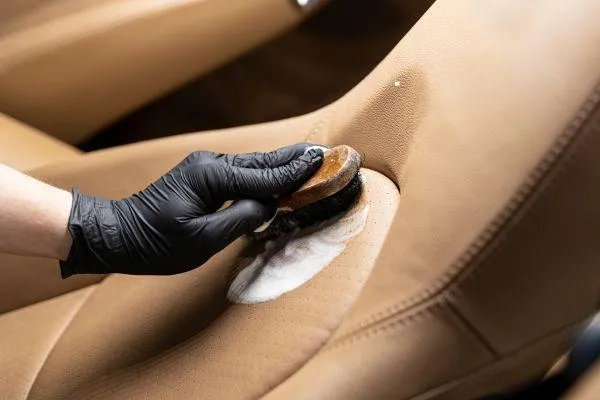Our Car Detailing Blog Page
SAZ Detailing's blog offers expert car care tips, detailing techniques, and maintenance advice to keep your vehicle in pristine condition.
Explore our articles for insights on interior and exterior detailing, product recommendations, and best practices to enhance your car's appearance and longevity.

Our Car Detailing Blog Page
SAZ Detailing's blog offers expert car care tips, detailing techniques, and maintenance advice to keep your vehicle in pristine condition.
Explore our articles for insights on interior and exterior detailing, product recommendations, and best practices to enhance your car's appearance and longevity.

The Ultimate Guide to Cleaning Car Leather Seats
The Ultimate Guide to Cleaning Car Leather Seats
Maintaining the pristine condition of your car's leather seats is essential for preserving the luxury and comfort of your ride. Whether you’re a car enthusiast, a luxury car owner, or a DIY lover, knowing how to clean and care for your car’s leather seats can make a world of difference. In this comprehensive guide, we'll walk you through everything you need to know to keep your car's leather seats looking and feeling like new.
Introduction
Leather seats add a touch of elegance to any car, but they require proper maintenance to stay in top shape. Regular cleaning and conditioning not only keep the seats looking great but also extend their lifespan. In this blog post, we’ll cover the importance of maintaining car leather seats, the types of leather used in car interiors, and the step-by-step process for cleaning and protecting your leather seats. By the end, you’ll be equipped with all the knowledge you need to keep your car's leather seats in perfect condition.
Understanding Leather Seats
Types of Leather Commonly Used in Car Interiors
There are several types of leather commonly used in car interiors, each with its unique characteristics. The most common types include aniline, semi-aniline, and pigmented leather. Aniline leather is the most natural and luxurious, but it is also the most susceptible to staining. Semi-aniline leather has a light protective coating, making it more durable while still retaining a natural look. Pigmented leather, on the other hand, has a heavy protective coating, making it the most durable and easy to clean.
How to Identify the Type of Leather in Your Car
Identifying the type of leather in your car is crucial for choosing the right cleaning products and methods. To determine the type of leather, check your car’s manual or consult the manufacturer’s website. You can also perform a simple water drop test. Place a drop of water on an inconspicuous area of the leather seat. If the water absorbs quickly, it’s likely aniline leather. If it sits on the surface for a while, it’s probably semi-aniline or pigmented leather.

Preparing for the Clean
Gathering the Necessary Tools and Products
Before you start cleaning your car’s leather seats, gather all the necessary tools and products. You’ll need a vacuum cleaner with a soft brush attachment, a high-quality leather cleaner, a microfiber cloth, a soft-bristle brush, a clean, damp cloth, and a leather conditioner. Make sure to choose products specifically designed for automotive leather to avoid damaging the seats.
Setting Up a Safe and Clean Workspace
Choose a well-ventilated area to clean your car’s leather seats, preferably in the shade to prevent the cleaner from drying too quickly. Make sure your workspace is free of dust and debris that could scratch the leather. Lay down a clean cloth or plastic sheet to protect the surrounding areas.
Step-by-Step Cleaning Process
Vacuuming to Remove Surface Dirt and Debris
Start by vacuuming the seats to remove any loose dirt and debris. Use the soft brush attachment to avoid scratching the leather. Pay special attention to the crevices and seams where dirt tends to accumulate. This step is crucial for preventing dirt from being rubbed into the leather during the cleaning process.
Applying Leather Cleaner with Gentle Circular Motions
Spray the leather cleaner onto a microfiber cloth or soft-bristle brush. Gently apply the cleaner to the leather using circular motions. Avoid using excessive force, as this can damage the leather. Work in small sections to ensure even coverage.
Wiping Down with a Clean, Damp Cloth
After applying the cleaner, wipe down the leather with a clean, damp cloth to remove any residue. Make sure to wring out the cloth well to avoid soaking the leather. This step helps remove the cleaner and any loosened dirt.
Drying and Conditioning the Leather to Prevent Cracking
Allow the leather to air dry completely before applying a leather conditioner. Conditioning the leather helps keep it soft and supple, preventing cracking over time. Apply the conditioner with a clean microfiber cloth, working it into the leather using gentle circular motions. Follow the manufacturer’s instructions for the best results.
Tips for Stain Removal
Specific Advice for Common Stains Like Ink, Food, or Oils
Accidents happen, and stains are inevitable. Here are some tips for removing common stains from leather seats:
Ink Stains: Dab the stain with a cloth soaked in rubbing alcohol, then wipe with a damp cloth.
Food Stains: Gently blot the stain with a mixture of mild soap and water. Avoid rubbing, as this can spread the stain.
Oil Stains: Sprinkle baking soda on the stain and let it sit for a few hours to absorb the oil, then vacuum it off.
Always test any cleaning method on an inconspicuous area first to ensure it doesn’t damage the leather.

Maintenance and Protection
How to Properly Maintain Your Car's Leather Seats to Extend Their Lifespan
Regular maintenance is key to keeping your car’s leather seats in top condition. Clean the seats monthly to prevent dirt buildup and condition them every three to six months to keep the leather soft and supple. Avoid exposing the seats to direct sunlight for extended periods, as UV rays can cause fading and cracking.
Recommendations for Leather Protectants
In addition to regular cleaning and conditioning, using a leather protectant can help shield the seats from spills and stains. Look for a protectant specifically designed for automotive leather and apply it according to the manufacturer’s instructions. This extra layer of protection can make a significant difference in the longevity of your leather seats.
Conclusion
Maintaining your car’s leather seats is essential for preserving their appearance and extending their lifespan. If you live in New Jersey and are interested in car detailing done by experts, reach out to us at 551-999-2970!

The Ultimate Guide to Cleaning Car Leather Seats
The Ultimate Guide to Cleaning Car Leather Seats
Maintaining the pristine condition of your car's leather seats is essential for preserving the luxury and comfort of your ride. Whether you’re a car enthusiast, a luxury car owner, or a DIY lover, knowing how to clean and care for your car’s leather seats can make a world of difference. In this comprehensive guide, we'll walk you through everything you need to know to keep your car's leather seats looking and feeling like new.
Introduction
Leather seats add a touch of elegance to any car, but they require proper maintenance to stay in top shape. Regular cleaning and conditioning not only keep the seats looking great but also extend their lifespan. In this blog post, we’ll cover the importance of maintaining car leather seats, the types of leather used in car interiors, and the step-by-step process for cleaning and protecting your leather seats. By the end, you’ll be equipped with all the knowledge you need to keep your car's leather seats in perfect condition.
Understanding Leather Seats
Types of Leather Commonly Used in Car Interiors
There are several types of leather commonly used in car interiors, each with its unique characteristics. The most common types include aniline, semi-aniline, and pigmented leather. Aniline leather is the most natural and luxurious, but it is also the most susceptible to staining. Semi-aniline leather has a light protective coating, making it more durable while still retaining a natural look. Pigmented leather, on the other hand, has a heavy protective coating, making it the most durable and easy to clean.
How to Identify the Type of Leather in Your Car
Identifying the type of leather in your car is crucial for choosing the right cleaning products and methods. To determine the type of leather, check your car’s manual or consult the manufacturer’s website. You can also perform a simple water drop test. Place a drop of water on an inconspicuous area of the leather seat. If the water absorbs quickly, it’s likely aniline leather. If it sits on the surface for a while, it’s probably semi-aniline or pigmented leather.

Preparing for the Clean
Gathering the Necessary Tools and Products
Before you start cleaning your car’s leather seats, gather all the necessary tools and products. You’ll need a vacuum cleaner with a soft brush attachment, a high-quality leather cleaner, a microfiber cloth, a soft-bristle brush, a clean, damp cloth, and a leather conditioner. Make sure to choose products specifically designed for automotive leather to avoid damaging the seats.
Setting Up a Safe and Clean Workspace
Choose a well-ventilated area to clean your car’s leather seats, preferably in the shade to prevent the cleaner from drying too quickly. Make sure your workspace is free of dust and debris that could scratch the leather. Lay down a clean cloth or plastic sheet to protect the surrounding areas.
Step-by-Step Cleaning Process
Vacuuming to Remove Surface Dirt and Debris
Start by vacuuming the seats to remove any loose dirt and debris. Use the soft brush attachment to avoid scratching the leather. Pay special attention to the crevices and seams where dirt tends to accumulate. This step is crucial for preventing dirt from being rubbed into the leather during the cleaning process.
Applying Leather Cleaner with Gentle Circular Motions
Spray the leather cleaner onto a microfiber cloth or soft-bristle brush. Gently apply the cleaner to the leather using circular motions. Avoid using excessive force, as this can damage the leather. Work in small sections to ensure even coverage.
Wiping Down with a Clean, Damp Cloth
After applying the cleaner, wipe down the leather with a clean, damp cloth to remove any residue. Make sure to wring out the cloth well to avoid soaking the leather. This step helps remove the cleaner and any loosened dirt.
Drying and Conditioning the Leather to Prevent Cracking
Allow the leather to air dry completely before applying a leather conditioner. Conditioning the leather helps keep it soft and supple, preventing cracking over time. Apply the conditioner with a clean microfiber cloth, working it into the leather using gentle circular motions. Follow the manufacturer’s instructions for the best results.
Tips for Stain Removal
Specific Advice for Common Stains Like Ink, Food, or Oils
Accidents happen, and stains are inevitable. Here are some tips for removing common stains from leather seats:
Ink Stains: Dab the stain with a cloth soaked in rubbing alcohol, then wipe with a damp cloth.
Food Stains: Gently blot the stain with a mixture of mild soap and water. Avoid rubbing, as this can spread the stain.
Oil Stains: Sprinkle baking soda on the stain and let it sit for a few hours to absorb the oil, then vacuum it off.
Always test any cleaning method on an inconspicuous area first to ensure it doesn’t damage the leather.

Maintenance and Protection
How to Properly Maintain Your Car's Leather Seats to Extend Their Lifespan
Regular maintenance is key to keeping your car’s leather seats in top condition. Clean the seats monthly to prevent dirt buildup and condition them every three to six months to keep the leather soft and supple. Avoid exposing the seats to direct sunlight for extended periods, as UV rays can cause fading and cracking.
Recommendations for Leather Protectants
In addition to regular cleaning and conditioning, using a leather protectant can help shield the seats from spills and stains. Look for a protectant specifically designed for automotive leather and apply it according to the manufacturer’s instructions. This extra layer of protection can make a significant difference in the longevity of your leather seats.
Conclusion
Maintaining your car’s leather seats is essential for preserving their appearance and extending their lifespan. If you live in New Jersey and are interested in car detailing done by experts, reach out to us at 551-999-2970!

Serving Bergen County and surrounding areas, including Franklin Lakes, Glen Rock, Saddle River, Upper Saddle River, Wyckoff, Oakland, Alpine, Cresskill, Wayne, Parsippany-Troy Hills, Montville, Cedar Grove, Fairfield, Pequannock Township (Pompton Plains), Little Falls, and Hawthorne, NJ with quality car detailing services, year-round.
Other Services: Steering Wheel Cleaning | Headlight Restoration | Interior Car Cleaning | Car Carpet Cleaning | Car Upholstery Cleaning | Car Seat Stain Removal | Truck Detailing | Luxury Car Detailing

